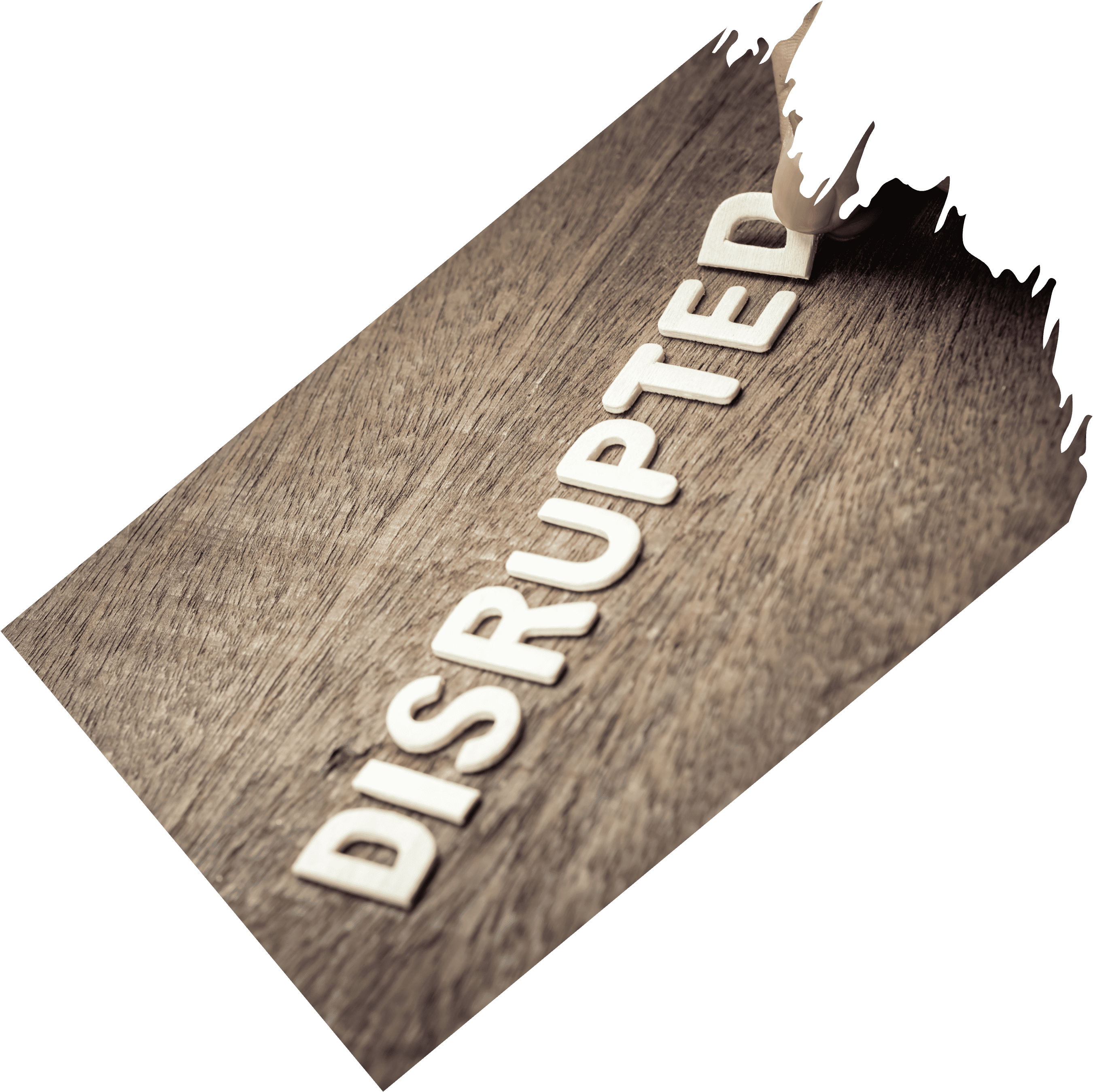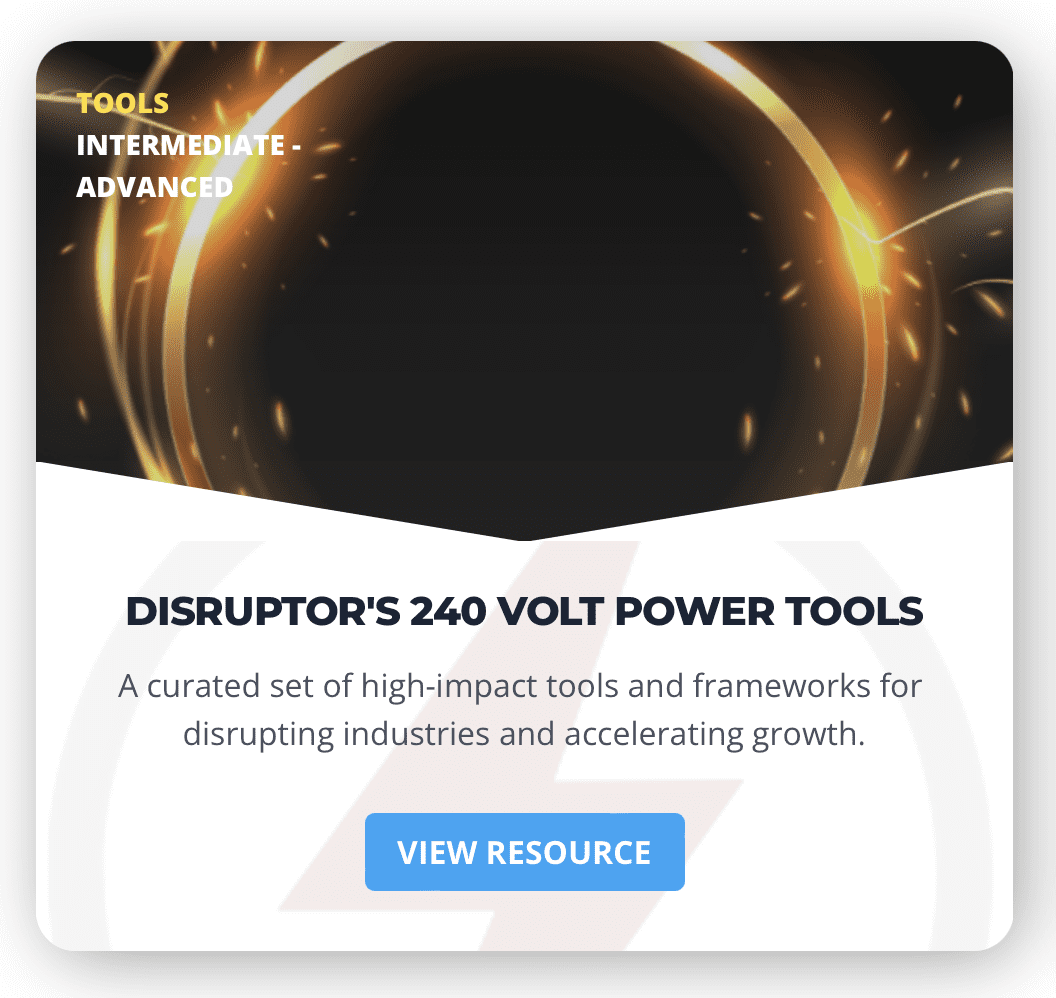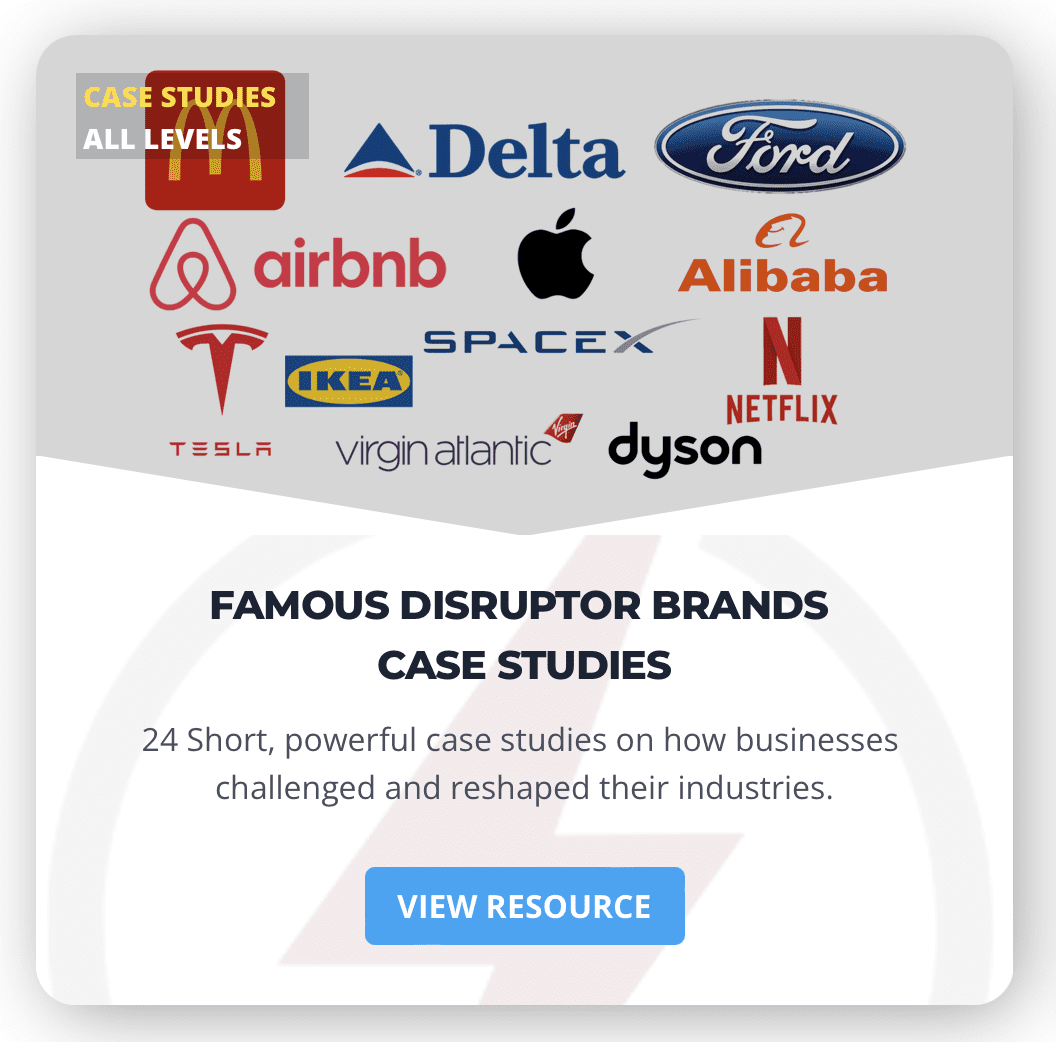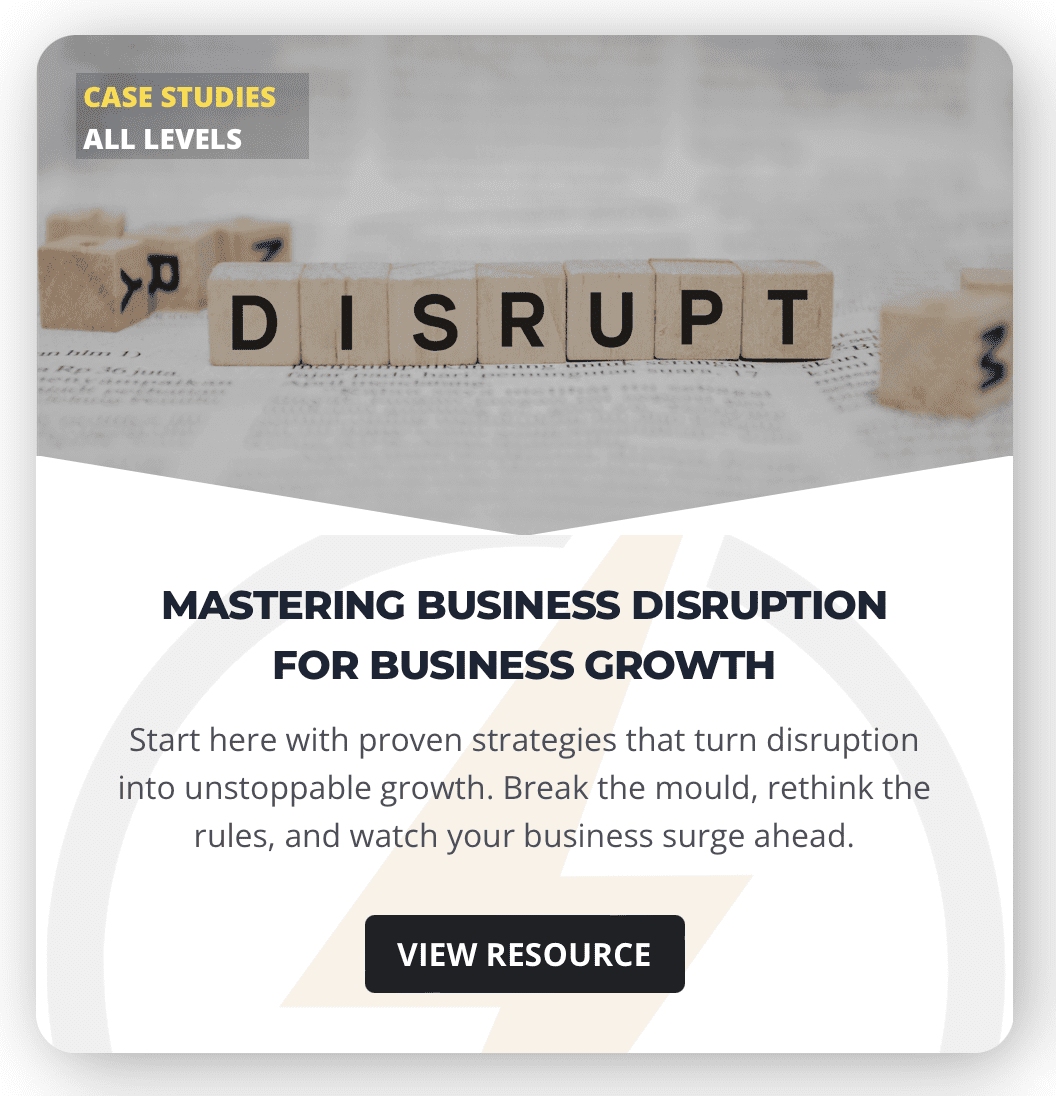REVIEW PAGE 3: FAMOUS DISRUPTOR BRANDS
Financial Services & FinTech Case Studies
What does it take to disrupt an entire industry? Sometimes, it’s a single bold decision. Other times, it’s a subtle shift that rewrites the rules over time. This collection of case studies showcases how well-known brands—across a wide range of industries—broke with convention, challenged assumptions, and reshaped their markets.
Each brief, high-impact case highlights a specific challenge, the bold move taken, the result achieved, and the key takeaway. These stories offer inspiration and insight for anyone looking to lead rather than follow—whether you're building a business, growing a team, or rethinking your strategy.

REVIEWS:
FINANCIAL SERVICES & FINTECH CASE STUDIES
The financial world has long been resistant to change—until now. These examples reveal how disruptors challenged outdated systems, prioritised user experience, and introduced smarter, faster, and fairer ways to handle money.
Click the title link below to view:
Want to dig deeper? A more detailed Business Disruptor Club section breaks down how these disruptors executed their strategies—and how you can apply their playbook to your own ventures.
Also See:





“The best way to predict the future is to create it.”
Peter Drucker

“Business Disruptors Club — For those who don’t follow the rules. They rewrite them.”
© Copyright 2025. Business Disruptors . All Rights Reserved.
Book Your FREE 30-min Strategy Call Now
Enter your details below to get instant access to [enter lead magnet name here]
We process your personal data as stated in our Privacy Policy. You may withdraw your consent at any time by clicking the unsubscribe link at the bottom of any of our emails.
REGISTER YOUR SPOT NOW
Enter your details below to get instant access to [enter lead magnet name here]
We process your personal data as stated in our Privacy Policy. You may withdraw your consent at any time by clicking the unsubscribe link at the bottom of any of our emails.
How Dyson Revolutionised Home Appliances
The Challenge:
The home appliance market was dominated by traditional designs, offering little innovation and often compromising on performance.
The Bold Move:
Dyson disrupted the industry by developing bagless vacuum cleaners with cyclone technology, providing superior suction and eliminating the hassle of disposable vacuum bags. They later expanded to other innovative products like bladeless fans, air purifiers, and hairdryers.
The Result:
Dyson became synonymous with high-performance, cutting-edge design, capturing significant market share and reshaping consumer expectations for household appliances.
Key Takeaway:
Innovation isn’t just about function—it’s about reimagining how products look, feel, and work. Stand out by solving problems consumers didn’t know they had.
How Spotify Transformed Music Consumption
The Challenge
The music industry faced declining sales due to piracy and outdated distribution models, leaving artists and record labels struggling to monetise their work.
The Bold Move
Spotify introduced a subscription-based streaming model, giving users instant access to a vast library of music while compensating artists through licensing deals. By offering both free (ad-supported) and premium tiers, they made legal music access more attractive than piracy.
The Result
Spotify revolutionised the way people consume music, amassing over 500 million active users globally and becoming the leading music streaming platform. It also reshaped the industry’s revenue streams by prioritizing streaming over physical and digital sales.
Key Takeaway
Disrupting an industry often requires aligning value for both the consumer and the supplier. Create a model that benefits all stakeholders to ensure widespread adoption.
How Arm Holdings Redefined Microprocessor Architecture
The Challenge
Microprocessors were traditionally designed for high performance, resulting in power-hungry chips unsuitable for mobile and embedded devices.
The Bold Move
Arm Holdings developed energy-efficient, scalable chip architectures that prioritized low power consumption without compromising performance. They licensed their designs to manufacturers rather than producing chips themselves, enabling rapid adoption across multiple industries.
The Result
Arm’s architecture became the backbone of mobile computing, powering over 95% of smartphones globally, as well as IoT devices, wearables, and beyond. The licensing model disrupted traditional manufacturing, creating an ecosystem of innovation.
Key Takeaway
Sometimes the greatest innovation lies in a scalable business model. Focus on enabling others to build upon your technology to achieve exponential growth.
How Skype Transformed Communication
The Challenge
Traditional phone calls, especially international ones, were expensive and inaccessible for many users.
The Bold Move
Skype introduced free, internet-based voice and video calls, leveraging peer-to-peer technology to keep costs low. They made global communication accessible to everyone with a stable internet connection.
The Result
Skype became synonymous with internet-based communication, acquiring hundreds of millions of users and disrupting the telecom industry.
Key Takeaway
Making communication faster, easier, and more affordable can transform how people interact on a global scale.
How Huawei Disrupted Global Telecommunications
The Challenge
Telecommunications infrastructure was dominated by Western companies, often providing expensive and rigid solutions that excluded many emerging markets.
The Bold Move
Huawei entered the market with cost-effective, high-quality telecom equipment and invested heavily in R&D to stay ahead of technological trends. They focused on partnerships with developing countries, offering affordable solutions tailored to their needs.
The Result
Huawei became a global leader in telecommunications, overtaking competitors like Ericsson and Nokia. They now play a key role in 5G deployment worldwide, reshaping connectivity across industries.
Key Takeaway
Disruption often comes from serving underserved markets with tailored, affordable solutions—especially in industries where incumbents overlook emerging opportunities.
REGISTER YOUR SPOT NOW
Enter your details below to get instant access to [enter lead magnet name here]
We process your personal data as stated in our Privacy Policy. You may withdraw your consent at any time by clicking the unsubscribe link at the bottom of any of our emails.
How Nokia Pioneered the Mobile Phone Revolution
The Challenge
In the 1990s, mobile phones were bulky, expensive, and primarily targeted at businesses. The consumer market remained untapped due to cost and accessibility barriers.
The Bold Move
Nokia focused on creating user-friendly, affordable mobile phones for the masses, leveraging streamlined manufacturing and innovative marketing strategies. They also standardised GSM technology, which became the backbone of global mobile communication.
The Result
By the early 2000s, Nokia dominated the mobile phone market, with iconic models like the 3310 becoming cultural phenomena. Their efforts connected millions of people worldwide, revolutionising communication on a global scale.
Key Takeaway
Disruption often involves democratising access to technology—making products affordable, user-friendly, and accessible to a broader audience.
How TikTok Redefined Social Media
The Challenge:
The home appliance market was dominated by traditional designs, offering little innovation and often compromising on performance.
The Bold Move:
Dyson disrupted the industry by developing bagless vacuum cleaners with cyclone technology, providing superior suction and eliminating the hassle of disposable vacuum bags. They later expanded to other innovative products like bladeless fans, air purifiers, and hairdryers.
The Result:
Dyson became synonymous with high-performance, cutting-edge design, capturing significant market share and reshaping consumer expectations for household appliances.
Key Takeaway:
Innovation isn’t just about function—it’s about reimagining how products look, feel, and work. Stand out by solving problems consumers didn’t know they had.
How Zoom Transformed Virtual Communication
The Challenge
Video conferencing was clunky, unreliable, and often limited to corporate users, leaving smaller organisations and individuals underserved.
The Bold Move
Zoom introduced a simple, reliable, and scalable video conferencing platform that prioritised ease of use and high-quality performance. Their freemium model made it accessible to a wide audience.
The Result
Zoom became the global leader in video conferencing, with its usage skyrocketing during the pandemic, reshaping how businesses, schools, and families connect.
Key Takeaway
Simplifying user experience while maintaining scalability can disrupt even established industries, turning a niche product into a global necessity.
How Tesla Solar Disrupted Renewable Energy
The Challenge
Renewable energy solutions, like solar power, were expensive and unattractive, with limited scalability for residential customers.
The Bold Move
Tesla introduced sleek solar roof tiles and Powerwall batteries, offering a fully integrated system that combined aesthetics with energy independence. They targeted sustainability-conscious consumers and positioned solar energy as both a practical and aspirational product.
The Result
Tesla Solar redefined the residential energy market, leading the charge toward sustainable energy while inspiring competitors to innovate.
Key Takeaway
Reimagining a product’s design and usability can turn a niche solution into a mainstream disruptor.
How Apple Redefined Technology and Design
The Challenge
In the late 1970s and beyond, computers were complex, clunky, and accessible only to tech-savvy users or businesses, leaving the average consumer disconnected from the digital revolution.
The Bold Move
Apple disrupted the industry with user-friendly, beautifully designed products, starting with the Apple II and later the Macintosh. They continued to revolutionise markets with the iPod (music), iPhone (smartphones), and iPad (tablets), combining sleek design, intuitive interfaces, and innovative ecosystems like the App Store.
The Result
Apple became one of the most valuable companies in the world, reshaping how people interact with technology and setting the benchmark for innovation, branding, and customer loyalty.
Key Takeaway
True disruption is about merging simplicity with sophistication—make complex technologies intuitive, accessible, and visually appealing to create transformative experiences.
How Sony Revolutionised Consumer Electronics
The Challenge
In the 1970s, portable music was limited to cumbersome devices, and there was no way for people to enjoy personal, high-quality audio on the go.
The Bold Move
Sony introduced the Walkman, a compact cassette player that combined portability with high-quality sound. They marketed it as a personal and lifestyle-oriented product, revolutionising how people experienced music.
The Result
The Walkman became a cultural phenomenon, selling over 400 million units and paving the way for future portable devices like MP3 players and smartphones.
Key Takeaway
Disruption often involves creating entirely new use cases for existing technology—focus on how a product can fit seamlessly into consumers’ lives.
How Microsoft Democratised Personal Computing
The Challenge
In the late 1970s and early 1980s, personal computers were inaccessible to the average consumer due to high costs and complex operating systems.
The Bold Move
Microsoft developed an affordable, user-friendly operating system (MS-DOS and later Windows) that could run on a wide variety of hardware. By licensing their software to manufacturers rather than producing hardware themselves, they created an ecosystem of compatible PCs.
The Result
Microsoft became the dominant player in personal computing, with Windows powering over 90% of the world's PCs at its peak. Their strategy transformed personal computing from a niche market into a global necessity.
Key Takeaway
Disruption often comes from scalability—focus on creating platforms that enable widespread adoption and partner with other innovators to accelerate growth.
REGISTER YOUR SPOT NOW
Enter your details below to get instant access to [enter lead magnet name here]
We process your personal data as stated in our Privacy Policy. You may withdraw your consent at any time by clicking the unsubscribe link at the bottom of any of our emails.
How Kodak Revolutionised Photography (Initially)
The Challenge
In the late 19th century, photography was cumbersome, expensive, and required significant technical knowledge, limiting its appeal to professionals and enthusiasts.
The Bold Move
Kodak introduced the first simple, consumer-friendly camera with the slogan, “You press the button, we do the rest.” They also popularised roll film, making photography accessible and affordable to the masses.
The Result
Kodak became synonymous with photography for decades, enabling millions of people to capture memories. While later disrupted by digital photography, Kodak’s early innovations reshaped the industry.
Key Takeaway
Simplifying technology for mass adoption can unlock entirely new markets and redefine consumer habits.
How Xerox Changed the Office Forever
The Challenge
Before the 1960s, duplicating documents was tedious and inefficient, relying on carbon paper or expensive, time-consuming processes.
The Bold Move
Xerox developed the first photocopier, making it possible to duplicate documents quickly and affordably. They also created a service-based business model, leasing machines and providing maintenance, which generated recurring revenue.
The Result
Xerox became a staple in offices worldwide, transforming the way businesses operated and creating a new standard for productivity.
Key Takeaway
Innovating tools that solve everyday business problems can disrupt industries and create entirely new markets.
How Nintendo Constantly Reinvented Gaming
The Challenge
The gaming industry faced stagnation during the early 1980s due to repetitive concepts and lack of innovation. Later, as consoles became more powerful, they focused on graphics over creative gameplay.
The Bold Move
Nintendo reinvented gaming multiple times, from the launch of the NES console that revived the gaming industry, to the Wii, which introduced motion-based gameplay, and the Switch, combining home and portable gaming. They emphasised creativity and inclusivity over pure technical specifications.
The Result
Nintendo became a global leader in gaming, selling hundreds of millions of consoles and building beloved franchises like Mario, Zelda, and Pokémon.
Key Takeaway
Disruption in technology often comes from redefining how people interact with products—not just improving specs but offering entirely new experiences.
How Ant Group Transformed Digital Finance
The Challenge
China’s cash-dominated economy lacked convenient, secure, and scalable digital payment solutions.
The Bold Move
Ant Group launched Alipay, a mobile payment platform integrated with e-commerce and daily services. They expanded into wealth management, lending, and insurance, creating a holistic digital finance ecosystem.
The Result
Ant Group became the world’s largest fintech company, revolutionising how consumers and businesses interact with financial services in China and beyond.
Key Takeaway
Bundling complementary services into an ecosystem creates unparalleled convenience and stickiness, fostering customer loyalty.
How TransferWise (now Wise) Revolutionised Money Transfers
The Challenge
Traditional international money transfers were expensive, slow, and lacked transparency, often burdening individuals and small businesses.
The Bold Move
Wise introduced a peer-to-peer money transfer model that bypassed traditional banking systems, offering low fees and real exchange rates. They built a transparent platform that showed users exactly how much they would save compared to banks.
The Result
Wise became a global leader in cross-border money transfers, serving over 13 million customers and transferring billions of dollars annually while maintaining low fees and speed.
Key Takeaway
Transparency and fairness in pricing can be powerful disruptors, particularly in industries where customers feel underserved or overcharged.
How Afterpay Disrupted Payment Systems
The Challenge
Consumers often struggled to make large purchases upfront, while retailers sought new ways to drive sales and increase customer loyalty.
The Bold Move
Afterpay introduced the "Buy Now, Pay Later" (BNPL) model, allowing consumers to split payments into interest-free installments. Their platform seamlessly integrated with retailers, making it easy for customers to shop and pay over time.
The Result
Afterpay became a global BNPL leader, driving billions in retail sales and setting a trend adopted by major payment providers like PayPal and Klarna.
Key Takeaway
Innovating around customer convenience can create new business models that transform payment experiences and boost sales.
How Alibaba Disrupted Global Commerce
The Challenge
Small businesses in China struggled to reach global markets, while consumers and enterprises lacked a reliable platform for sourcing goods and services.
The Bold Move
Alibaba created a comprehensive e-commerce ecosystem, including platforms for B2B (Alibaba.com), B2C (Tmall), and consumer marketplaces (Taobao). They introduced innovations like escrow payments to build trust and logistics networks to support rapid delivery.
The Result
Alibaba became the largest e-commerce company in the world, driving billions in sales annually and empowering millions of small businesses.
Key Takeaway
Building ecosystems that address the needs of all stakeholders—buyers, sellers, and logistics—can transform industries and create lasting impact.
How Ping An Insurance Innovated with AI Solutions
The Challenge
Traditional insurance processes were slow, complex, and inefficient, creating frustration for customers and insurers alike.
The Bold Move
Ping An Insurance adopted AI-powered systems for underwriting, claims processing, and fraud detection. They introduced tech-driven platforms that streamlined customer interactions, improving speed and accuracy.
The Result
Ping An became a global leader in insurance innovation, handling claims in minutes and setting a new standard for efficiency in financial services.
Key Takeaway
Leveraging emerging technologies like AI can disrupt even the most established industries by transforming customer experiences.
How Monzo Disrupted Traditional Banking
The Challenge
Traditional banks were slow, impersonal, and loaded with hidden fees, leaving a gap for modern, customer-friendly financial solutions.
The Bold Move
Monzo introduced a mobile-first banking app that provided real-time notifications, fee transparency, and seamless money management tools. Their prepaid card launched with viral community-driven campaigns, fostering trust and loyalty.
The Result
Monzo became one of the UK’s most popular challenger banks, growing to millions of customers and inspiring a wave of digital-first financial services worldwide.
Key Takeaway
Modernising customer experience through transparency and ease-of-use can disrupt even the most entrenched industries.
How American Express Reinvented Financial Services
The Challenge
Traditional financial services were limited to cash, checks, and complex banking systems, leaving a gap for faster, more flexible payment solutions.
The Bold Move
American Express introduced the first charge card, which offered consumers a new way to manage payments while earning loyalty benefits. They focused on affluent customers and positioned the card as a premium product.
The Result
American Express became a global leader in financial services, redefining how consumers interact with credit and loyalty programs while maintaining a premium brand image.
Key Takeaway
Create premium solutions that elevate the customer experience, even in commoditised industries, to build loyalty and a strong brand identity.